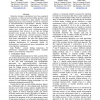418 search results - page 56 / 84 » Parallel Computation in Biological Sequence Analysis |
TCS
2008
13 years 7 months ago
2008
The longest common subsequence(LCS) problem is one of the classical and wellstudied problems in computer science. The computation of the LCS is a frequent task in DNA sequence ana...
BMCBI
2004
13 years 7 months ago
2004
Background: Signal transduction is one of the most important biological processes by which cells convert an external signal into a response. Novel computational approaches to mapp...
ICFCA
2004
Springer
14 years 1 months ago
2004
Springer
BLID (Bio-Logical Intelligent Database) is a bioinformatic system designed to help biologists extract new knowledge from raw genome data by providing high-level facilities for both...
BICOB
2010
Springer
14 years 20 days ago
2010
Springer
Molecular dynamics simulations have been employed by biologists to study the protein folding problem. Such simulations have resulted in a large number of protein folding trajector...
BMCBI
2004
13 years 7 months ago
2004
Background: Hidden Markov Models (HMMs) have proven very useful in computational biology for such applications as sequence pattern matching, gene-finding, and structure prediction...

